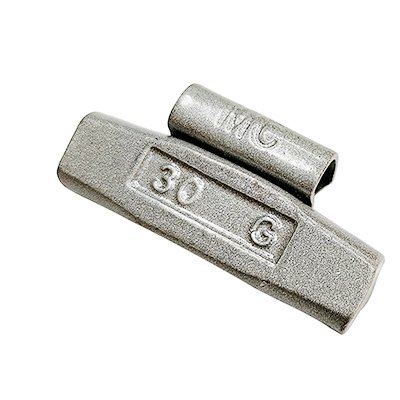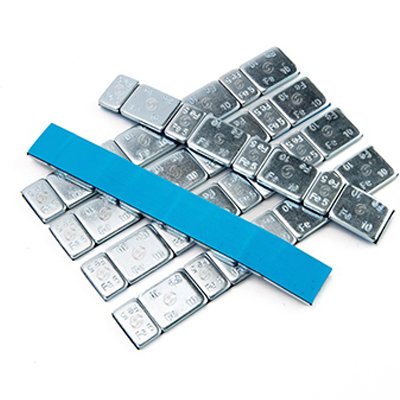Choosing the Right Wheel Weight: Stick-On vs Clip-On Wheel Weights
Wheel Weights Introduction Introduction
Tire wheel balance weight is a weight component installed on the wheel.
What is wheel weights?
Wheel weights are used to correct and offset imbalances found when balancing tire assemblies. Increasing the target weight results in an even distribution of the wheel's mass around the axis of rotation by applying weight to the appropriate locations on the wheel. This ensures that the wheel does not vibrate as it spins.
Wheel weight is an important component when balancing a customer's tires. For passenger car, motorcycle and truck wheels, there are two options: clip-on wheel weights and stick-on wheel weights.
Originally, clip-on weights were first patented in the early 1930s, but stick-on wheel weights began to enter the market in the early 1970s and provided a new way to balance aluminum rims.
Clip-on weights are traditionally used with wheels that have a flange to which a clip can be attached. Stick-on wheel weights are used on wheels without flanges, which can be hidden behind the spokes, and are often used by customers who are concerned about the aesthetics of their vehicle.
It is usually made of lead, iron, zinc and other materials, and is fixed on a specific position of the wheel hub by pasting or clamping. Its function is to compensate for the uneven mass distribution produced during the tire manufacturing and use process to ensure the dynamic balance of the tire and enable the wheel to run smoothly.
The main functions of tire balance weights are as follows:
- Keep the tires balanced: Keep the wheels balanced when rotating at high speed, prevent unbalanced centrifugal force, and avoid problems such as jitter and steering wheel vibration when the vehicle is driving.
- Improve driving comfort: Reduce bumps and discomfort caused by tire imbalance and improve driving experience.
- Protect vehicle components: Prevent unbalanced tires from causing additional wear and damage to vehicle suspension systems, steering systems or components.
- Ensure driving safety: Maintaining tire balance helps the vehicle drive stably and improve driving safety.
What is stick on wheel weight?
Sick-on balance weight is a counterweight component installed on the wheel. Its main function is to add appropriate counterweight to the part where the wheel mass is small, so that the wheel can maintain dynamic balance under high-speed rotation. It is usually made of lead, iron, zinc and other materials, and is fixed on a specific position of the wheel hub by pasting.
The use of stick-on balance weights is very simple. No tools are needed to fix the wheel weights, just stick them directly on the inside of the wheel hub.
Key features of stick on wheel balancing weights
Aesthetics: They are less visible than clip-on weights, which makes them a popular choice for expensive or stylized wheels.
Compatibility: Stick-on weights work well with modern alloy wheels, which often lack the lip required for clip-on weights.
Precision: They can be placed more accurately and offer a wider selection of weights for more precise balance.
what is clip on wheel weight?
The clip-on wheel weight is a counterweight component installed on the wheel by clamping. It is usually made of lead, iron, zinc and other materials. This kind of balance weight is firmly installed and not easy to fall off. It can effectively maintain the dynamic balance of the tire and ensure the stability and safety of the vehicle.
Key features of clip on wheel balancing weights
Durability: Due to their sturdiness, clip-on wheel weights can withstand harsh driving conditions better than stick-on wheel weights.
Easy to adjust: Clip-on weights can be easily moved or adjusted, providing greater flexibility.
Fit: They are often preferred for wheels that have a suitable edge or lip to clamp the weight.
Material of stick on wheel weight
Material of clip on wheel weight
Choose between clip-on and adhesive wheel
While both types of wheel weights serve the same basic purpose, the choice between snap-on weights and stick-on weights depends on several factors:
Wheel type: If your wheels have a pronounced lip or edge, snap-on weights may be a suitable choice. However, for modern, stylized or lip-less alloy wheels, stick-on weights would be a better option.
Aesthetic preferences: For those who prefer a clean look, a less noticeable stick-on weight may be more appealing.
Driving Conditions: If you regularly drive in harsh conditions, the durability of a hitch weight can provide a more reliable long-term solution.
All in all, clip-on wheel weights and stick-on wheel weights play a vital role in ensuring smooth and safe driving.
Use the right materials
Technicians should consider the following factors when selecting wheel weight materials:
- The density of wheel weight material will affect the size and thus wheel balance.
- Product fit, shape and function compared to traditional guide wheel weight.
- Environmental friendliness, recyclability and the impact of current national practices and future regulatory issues.
When choosing wheel weight options for your shop, the key is finding the right balance. Consider which material and application combination will work best for your technicians and your customers' wheels.


